Copenhagen Tourism Marketing Management Report - HT 3115
VerifiedAdded on 2022/09/15
|13
|3983
|12
Report
AI Summary
This report delves into the core principles of marketing within the tourism and hospitality sectors, emphasizing the significance of strategic planning, consumer behavior, and market segmentation. It critically examines the influence of macro-environmental factors such as political, economic, social, technological, environmental, and legal aspects on the industry, using the CopenHill case study in Copenhagen as a practical example. The report analyzes marketing management functions, including market research, marketing mix, and branding, and explores various marketing strategies like segmentation, targeting, and customer experience marketing. It also highlights the importance of brand awareness, customer relationships, and the use of digital marketing tools in attracting and retaining customers. The report concludes by offering recommendations for enhancing marketing effectiveness within the tourism and hospitality industry, emphasizing sustainable tourism practices and the integration of technology.
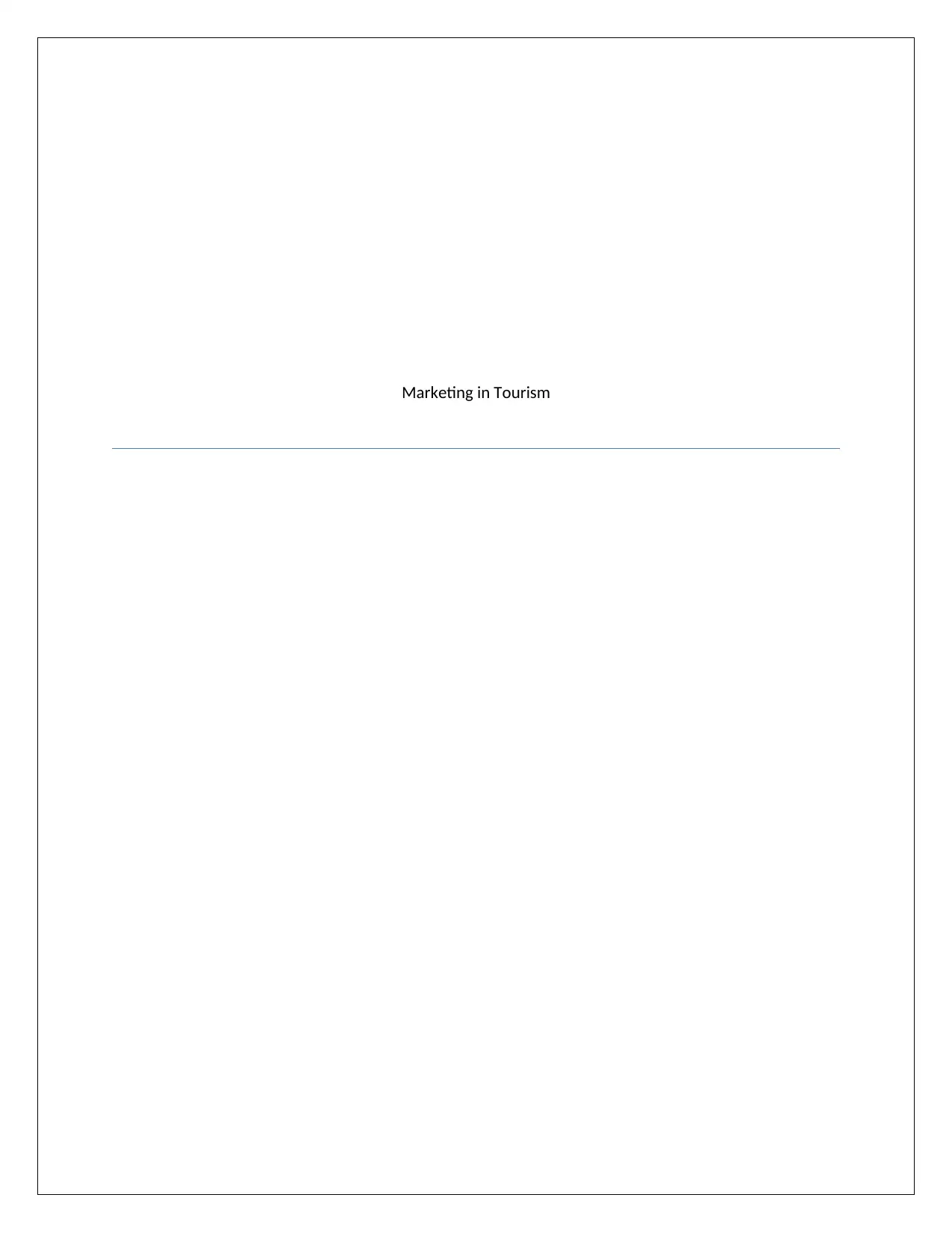
Marketing in Tourism
Paraphrase This Document
Need a fresh take? Get an instant paraphrase of this document with our AI Paraphraser
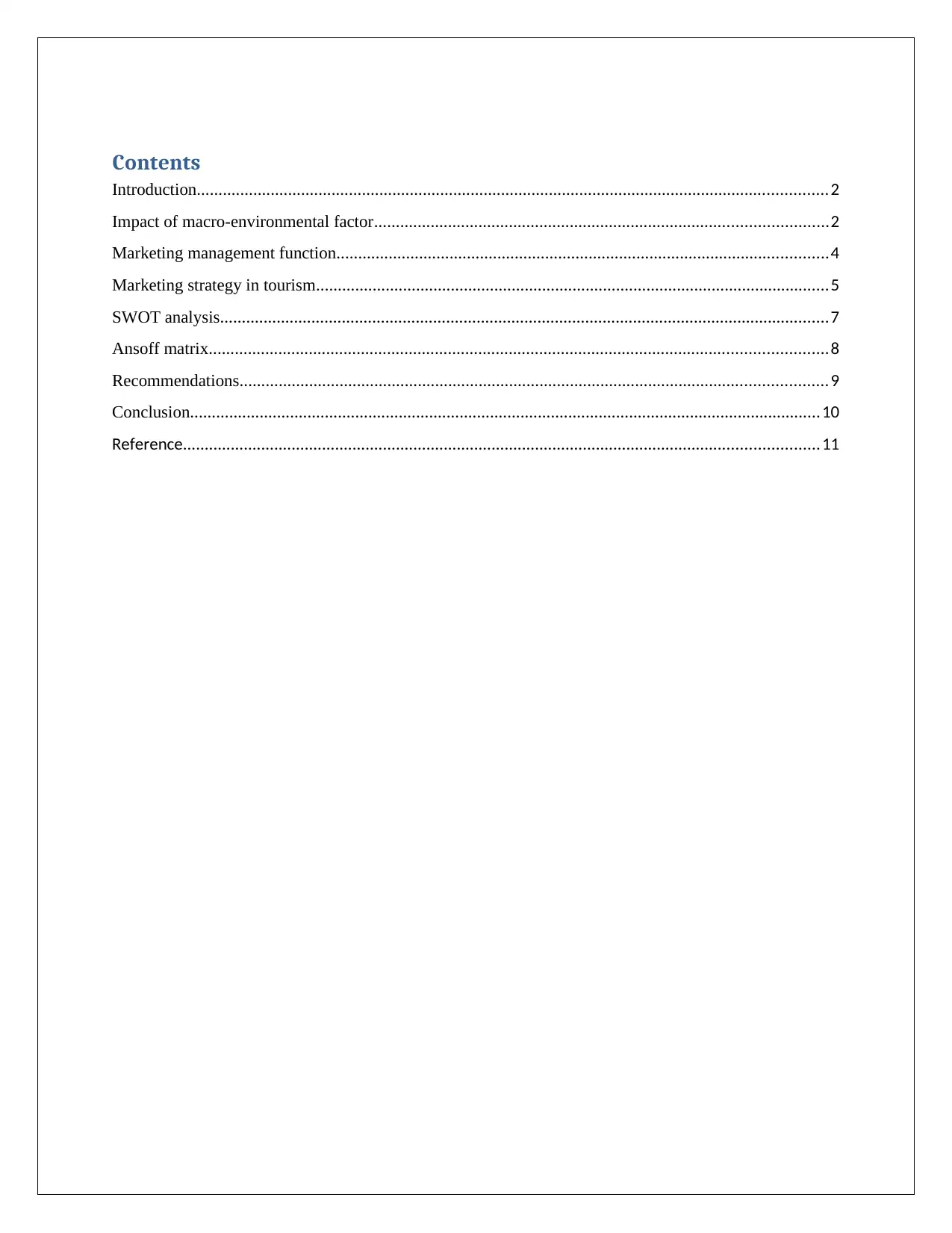
Contents
Introduction.................................................................................................................................................2
Impact of macro-environmental factor........................................................................................................2
Marketing management function.................................................................................................................4
Marketing strategy in tourism......................................................................................................................5
SWOT analysis............................................................................................................................................7
Ansoff matrix..............................................................................................................................................8
Recommendations.......................................................................................................................................9
Conclusion.................................................................................................................................................10
Reference..................................................................................................................................................11
Introduction.................................................................................................................................................2
Impact of macro-environmental factor........................................................................................................2
Marketing management function.................................................................................................................4
Marketing strategy in tourism......................................................................................................................5
SWOT analysis............................................................................................................................................7
Ansoff matrix..............................................................................................................................................8
Recommendations.......................................................................................................................................9
Conclusion.................................................................................................................................................10
Reference..................................................................................................................................................11
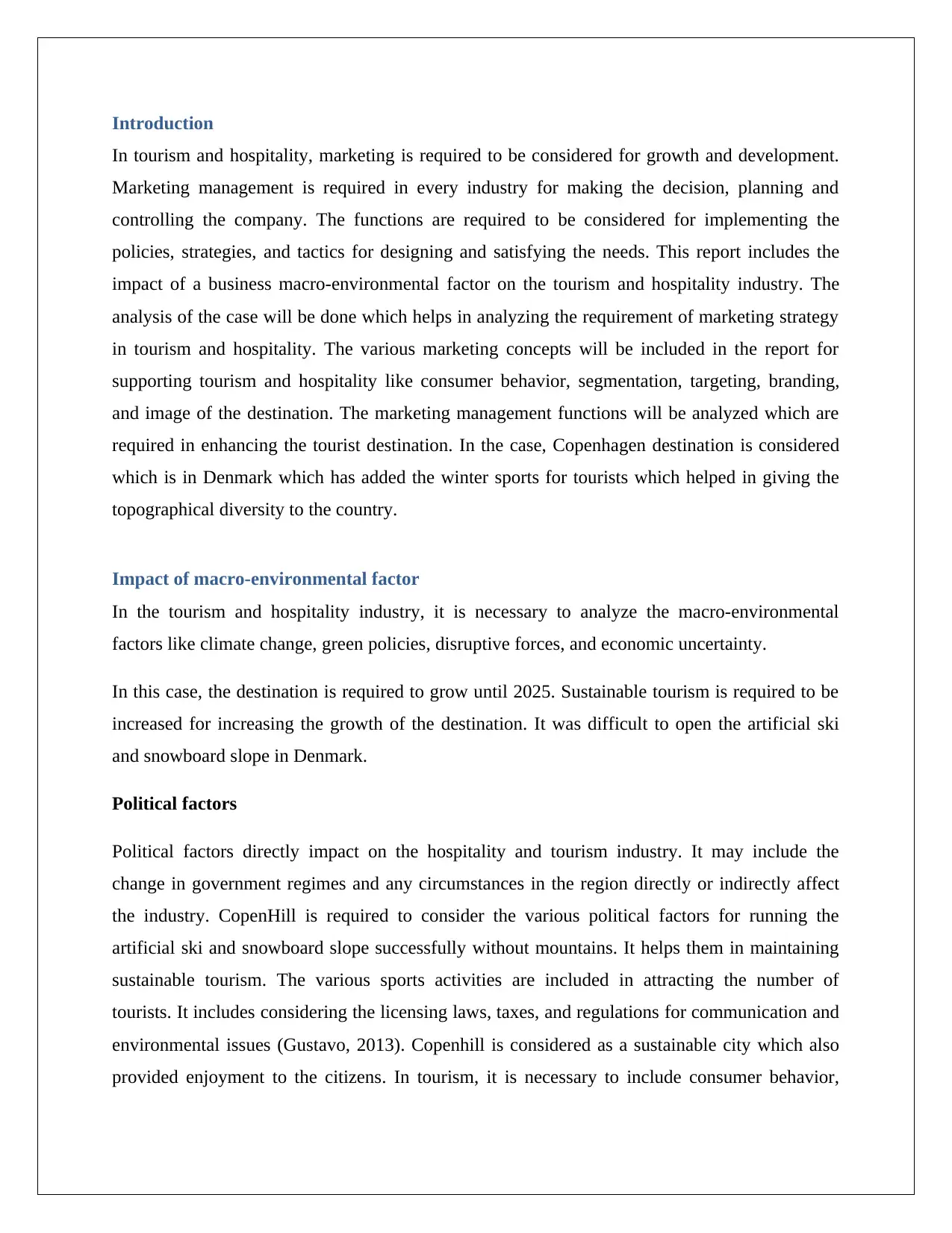
Introduction
In tourism and hospitality, marketing is required to be considered for growth and development.
Marketing management is required in every industry for making the decision, planning and
controlling the company. The functions are required to be considered for implementing the
policies, strategies, and tactics for designing and satisfying the needs. This report includes the
impact of a business macro-environmental factor on the tourism and hospitality industry. The
analysis of the case will be done which helps in analyzing the requirement of marketing strategy
in tourism and hospitality. The various marketing concepts will be included in the report for
supporting tourism and hospitality like consumer behavior, segmentation, targeting, branding,
and image of the destination. The marketing management functions will be analyzed which are
required in enhancing the tourist destination. In the case, Copenhagen destination is considered
which is in Denmark which has added the winter sports for tourists which helped in giving the
topographical diversity to the country.
Impact of macro-environmental factor
In the tourism and hospitality industry, it is necessary to analyze the macro-environmental
factors like climate change, green policies, disruptive forces, and economic uncertainty.
In this case, the destination is required to grow until 2025. Sustainable tourism is required to be
increased for increasing the growth of the destination. It was difficult to open the artificial ski
and snowboard slope in Denmark.
Political factors
Political factors directly impact on the hospitality and tourism industry. It may include the
change in government regimes and any circumstances in the region directly or indirectly affect
the industry. CopenHill is required to consider the various political factors for running the
artificial ski and snowboard slope successfully without mountains. It helps them in maintaining
sustainable tourism. The various sports activities are included in attracting the number of
tourists. It includes considering the licensing laws, taxes, and regulations for communication and
environmental issues (Gustavo, 2013). Copenhill is considered as a sustainable city which also
provided enjoyment to the citizens. In tourism, it is necessary to include consumer behavior,
In tourism and hospitality, marketing is required to be considered for growth and development.
Marketing management is required in every industry for making the decision, planning and
controlling the company. The functions are required to be considered for implementing the
policies, strategies, and tactics for designing and satisfying the needs. This report includes the
impact of a business macro-environmental factor on the tourism and hospitality industry. The
analysis of the case will be done which helps in analyzing the requirement of marketing strategy
in tourism and hospitality. The various marketing concepts will be included in the report for
supporting tourism and hospitality like consumer behavior, segmentation, targeting, branding,
and image of the destination. The marketing management functions will be analyzed which are
required in enhancing the tourist destination. In the case, Copenhagen destination is considered
which is in Denmark which has added the winter sports for tourists which helped in giving the
topographical diversity to the country.
Impact of macro-environmental factor
In the tourism and hospitality industry, it is necessary to analyze the macro-environmental
factors like climate change, green policies, disruptive forces, and economic uncertainty.
In this case, the destination is required to grow until 2025. Sustainable tourism is required to be
increased for increasing the growth of the destination. It was difficult to open the artificial ski
and snowboard slope in Denmark.
Political factors
Political factors directly impact on the hospitality and tourism industry. It may include the
change in government regimes and any circumstances in the region directly or indirectly affect
the industry. CopenHill is required to consider the various political factors for running the
artificial ski and snowboard slope successfully without mountains. It helps them in maintaining
sustainable tourism. The various sports activities are included in attracting the number of
tourists. It includes considering the licensing laws, taxes, and regulations for communication and
environmental issues (Gustavo, 2013). Copenhill is considered as a sustainable city which also
provided enjoyment to the citizens. In tourism, it is necessary to include consumer behavior,
⊘ This is a preview!⊘
Do you want full access?
Subscribe today to unlock all pages.

Trusted by 1+ million students worldwide
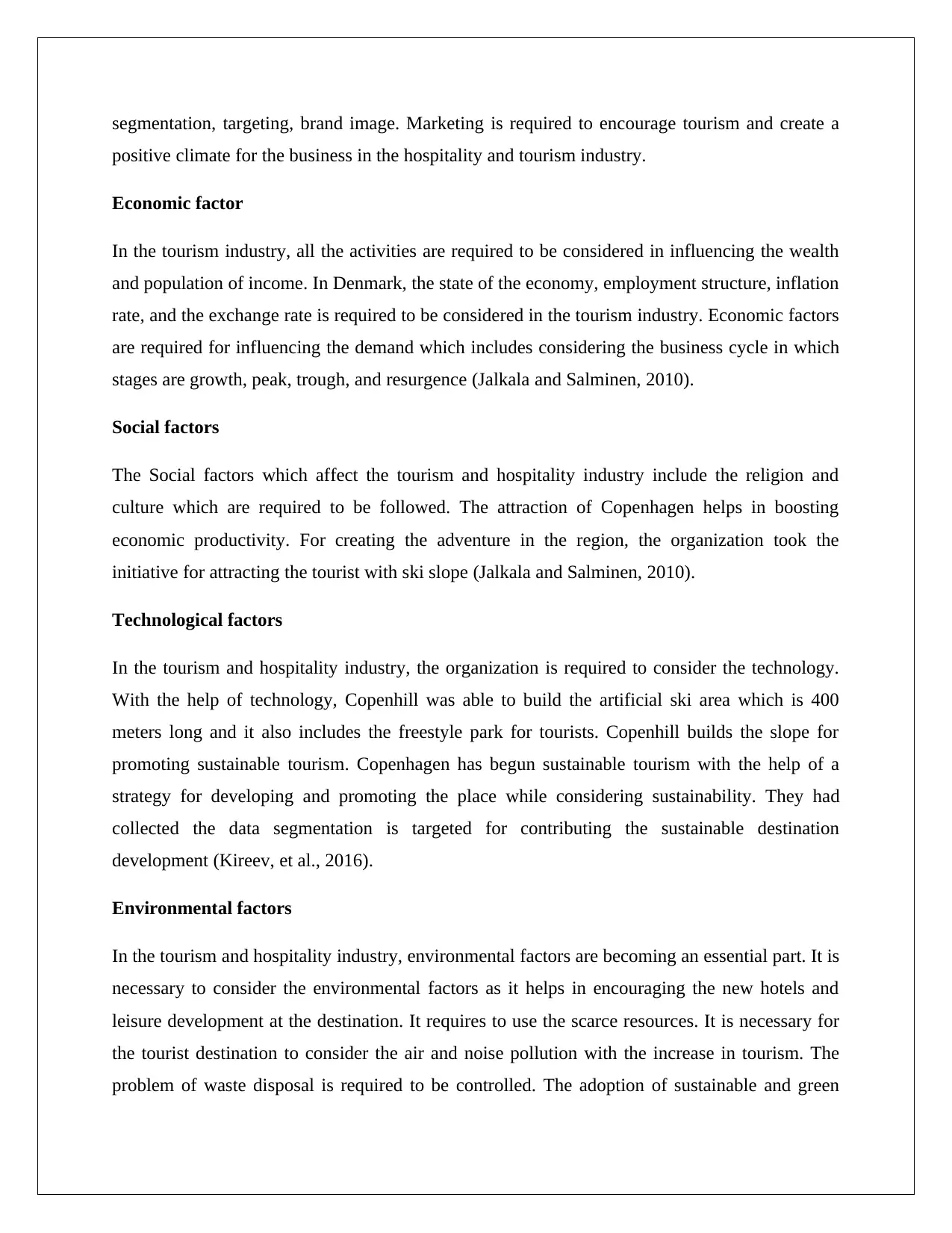
segmentation, targeting, brand image. Marketing is required to encourage tourism and create a
positive climate for the business in the hospitality and tourism industry.
Economic factor
In the tourism industry, all the activities are required to be considered in influencing the wealth
and population of income. In Denmark, the state of the economy, employment structure, inflation
rate, and the exchange rate is required to be considered in the tourism industry. Economic factors
are required for influencing the demand which includes considering the business cycle in which
stages are growth, peak, trough, and resurgence (Jalkala and Salminen, 2010).
Social factors
The Social factors which affect the tourism and hospitality industry include the religion and
culture which are required to be followed. The attraction of Copenhagen helps in boosting
economic productivity. For creating the adventure in the region, the organization took the
initiative for attracting the tourist with ski slope (Jalkala and Salminen, 2010).
Technological factors
In the tourism and hospitality industry, the organization is required to consider the technology.
With the help of technology, Copenhill was able to build the artificial ski area which is 400
meters long and it also includes the freestyle park for tourists. Copenhill builds the slope for
promoting sustainable tourism. Copenhagen has begun sustainable tourism with the help of a
strategy for developing and promoting the place while considering sustainability. They had
collected the data segmentation is targeted for contributing the sustainable destination
development (Kireev, et al., 2016).
Environmental factors
In the tourism and hospitality industry, environmental factors are becoming an essential part. It is
necessary to consider the environmental factors as it helps in encouraging the new hotels and
leisure development at the destination. It requires to use the scarce resources. It is necessary for
the tourist destination to consider the air and noise pollution with the increase in tourism. The
problem of waste disposal is required to be controlled. The adoption of sustainable and green
positive climate for the business in the hospitality and tourism industry.
Economic factor
In the tourism industry, all the activities are required to be considered in influencing the wealth
and population of income. In Denmark, the state of the economy, employment structure, inflation
rate, and the exchange rate is required to be considered in the tourism industry. Economic factors
are required for influencing the demand which includes considering the business cycle in which
stages are growth, peak, trough, and resurgence (Jalkala and Salminen, 2010).
Social factors
The Social factors which affect the tourism and hospitality industry include the religion and
culture which are required to be followed. The attraction of Copenhagen helps in boosting
economic productivity. For creating the adventure in the region, the organization took the
initiative for attracting the tourist with ski slope (Jalkala and Salminen, 2010).
Technological factors
In the tourism and hospitality industry, the organization is required to consider the technology.
With the help of technology, Copenhill was able to build the artificial ski area which is 400
meters long and it also includes the freestyle park for tourists. Copenhill builds the slope for
promoting sustainable tourism. Copenhagen has begun sustainable tourism with the help of a
strategy for developing and promoting the place while considering sustainability. They had
collected the data segmentation is targeted for contributing the sustainable destination
development (Kireev, et al., 2016).
Environmental factors
In the tourism and hospitality industry, environmental factors are becoming an essential part. It is
necessary to consider the environmental factors as it helps in encouraging the new hotels and
leisure development at the destination. It requires to use the scarce resources. It is necessary for
the tourist destination to consider the air and noise pollution with the increase in tourism. The
problem of waste disposal is required to be controlled. The adoption of sustainable and green
Paraphrase This Document
Need a fresh take? Get an instant paraphrase of this document with our AI Paraphraser
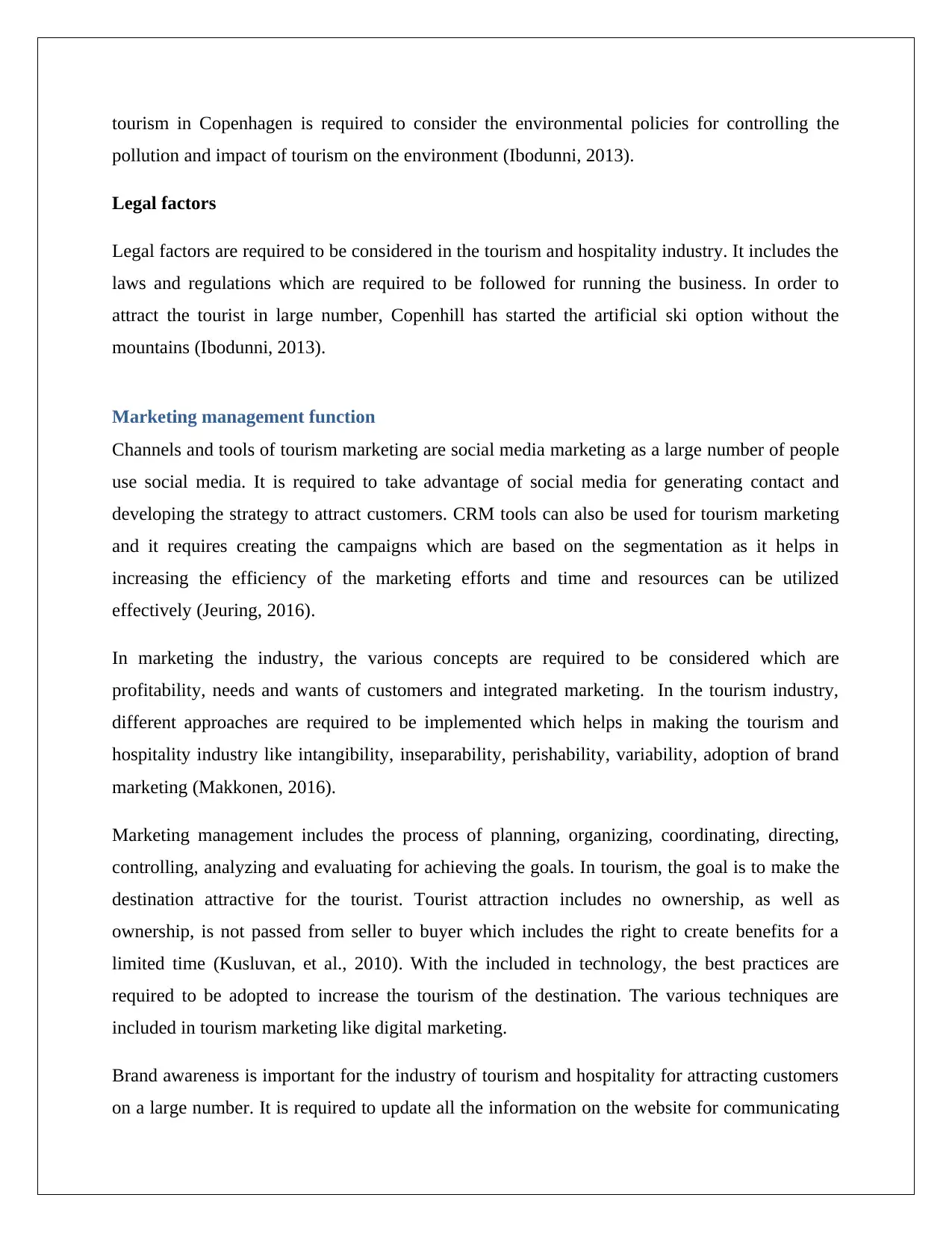
tourism in Copenhagen is required to consider the environmental policies for controlling the
pollution and impact of tourism on the environment (Ibodunni, 2013).
Legal factors
Legal factors are required to be considered in the tourism and hospitality industry. It includes the
laws and regulations which are required to be followed for running the business. In order to
attract the tourist in large number, Copenhill has started the artificial ski option without the
mountains (Ibodunni, 2013).
Marketing management function
Channels and tools of tourism marketing are social media marketing as a large number of people
use social media. It is required to take advantage of social media for generating contact and
developing the strategy to attract customers. CRM tools can also be used for tourism marketing
and it requires creating the campaigns which are based on the segmentation as it helps in
increasing the efficiency of the marketing efforts and time and resources can be utilized
effectively (Jeuring, 2016).
In marketing the industry, the various concepts are required to be considered which are
profitability, needs and wants of customers and integrated marketing. In the tourism industry,
different approaches are required to be implemented which helps in making the tourism and
hospitality industry like intangibility, inseparability, perishability, variability, adoption of brand
marketing (Makkonen, 2016).
Marketing management includes the process of planning, organizing, coordinating, directing,
controlling, analyzing and evaluating for achieving the goals. In tourism, the goal is to make the
destination attractive for the tourist. Tourist attraction includes no ownership, as well as
ownership, is not passed from seller to buyer which includes the right to create benefits for a
limited time (Kusluvan, et al., 2010). With the included in technology, the best practices are
required to be adopted to increase the tourism of the destination. The various techniques are
included in tourism marketing like digital marketing.
Brand awareness is important for the industry of tourism and hospitality for attracting customers
on a large number. It is required to update all the information on the website for communicating
pollution and impact of tourism on the environment (Ibodunni, 2013).
Legal factors
Legal factors are required to be considered in the tourism and hospitality industry. It includes the
laws and regulations which are required to be followed for running the business. In order to
attract the tourist in large number, Copenhill has started the artificial ski option without the
mountains (Ibodunni, 2013).
Marketing management function
Channels and tools of tourism marketing are social media marketing as a large number of people
use social media. It is required to take advantage of social media for generating contact and
developing the strategy to attract customers. CRM tools can also be used for tourism marketing
and it requires creating the campaigns which are based on the segmentation as it helps in
increasing the efficiency of the marketing efforts and time and resources can be utilized
effectively (Jeuring, 2016).
In marketing the industry, the various concepts are required to be considered which are
profitability, needs and wants of customers and integrated marketing. In the tourism industry,
different approaches are required to be implemented which helps in making the tourism and
hospitality industry like intangibility, inseparability, perishability, variability, adoption of brand
marketing (Makkonen, 2016).
Marketing management includes the process of planning, organizing, coordinating, directing,
controlling, analyzing and evaluating for achieving the goals. In tourism, the goal is to make the
destination attractive for the tourist. Tourist attraction includes no ownership, as well as
ownership, is not passed from seller to buyer which includes the right to create benefits for a
limited time (Kusluvan, et al., 2010). With the included in technology, the best practices are
required to be adopted to increase the tourism of the destination. The various techniques are
included in tourism marketing like digital marketing.
Brand awareness is important for the industry of tourism and hospitality for attracting customers
on a large number. It is required to update all the information on the website for communicating
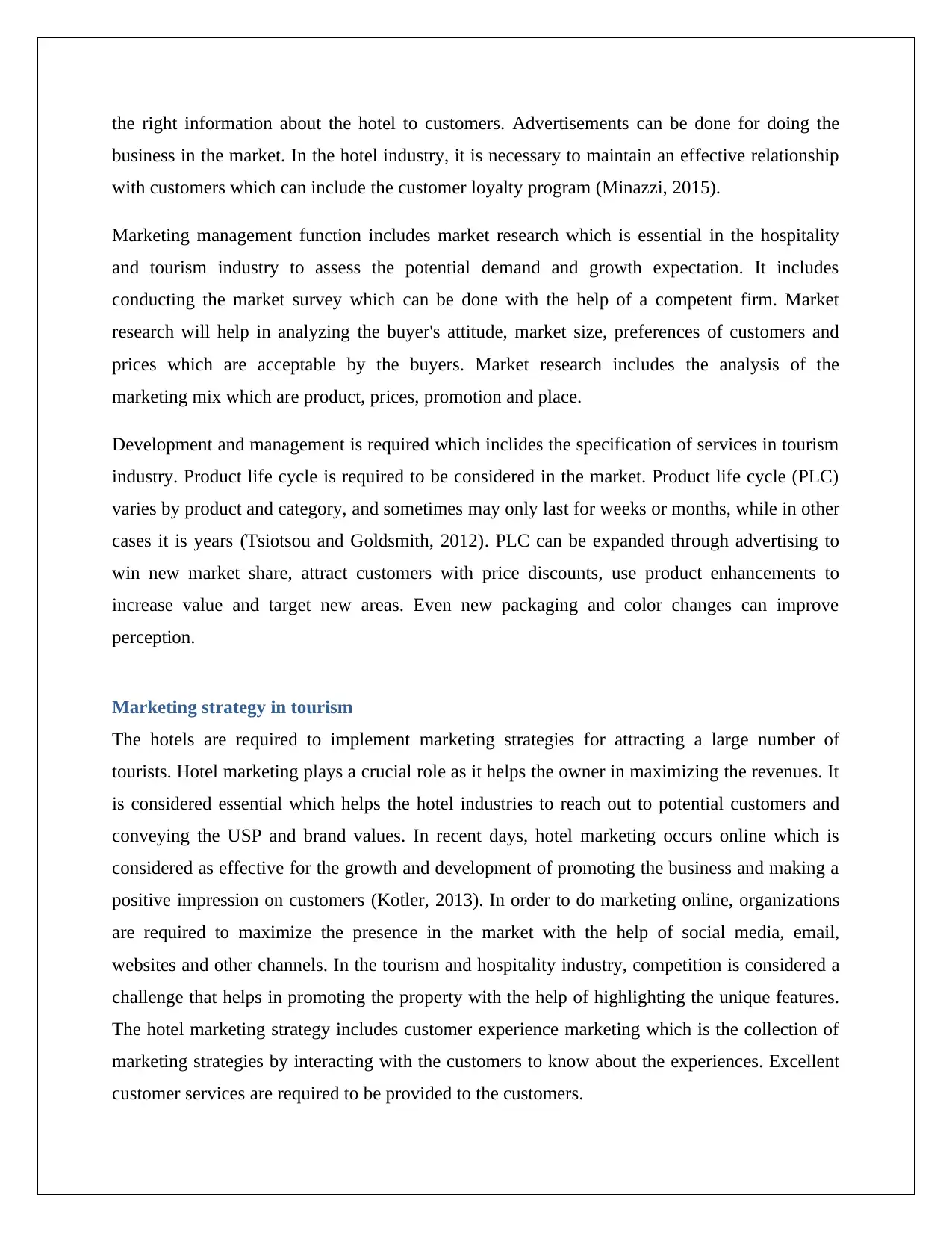
the right information about the hotel to customers. Advertisements can be done for doing the
business in the market. In the hotel industry, it is necessary to maintain an effective relationship
with customers which can include the customer loyalty program (Minazzi, 2015).
Marketing management function includes market research which is essential in the hospitality
and tourism industry to assess the potential demand and growth expectation. It includes
conducting the market survey which can be done with the help of a competent firm. Market
research will help in analyzing the buyer's attitude, market size, preferences of customers and
prices which are acceptable by the buyers. Market research includes the analysis of the
marketing mix which are product, prices, promotion and place.
Development and management is required which inclides the specification of services in tourism
industry. Product life cycle is required to be considered in the market. Product life cycle (PLC)
varies by product and category, and sometimes may only last for weeks or months, while in other
cases it is years (Tsiotsou and Goldsmith, 2012). PLC can be expanded through advertising to
win new market share, attract customers with price discounts, use product enhancements to
increase value and target new areas. Even new packaging and color changes can improve
perception.
Marketing strategy in tourism
The hotels are required to implement marketing strategies for attracting a large number of
tourists. Hotel marketing plays a crucial role as it helps the owner in maximizing the revenues. It
is considered essential which helps the hotel industries to reach out to potential customers and
conveying the USP and brand values. In recent days, hotel marketing occurs online which is
considered as effective for the growth and development of promoting the business and making a
positive impression on customers (Kotler, 2013). In order to do marketing online, organizations
are required to maximize the presence in the market with the help of social media, email,
websites and other channels. In the tourism and hospitality industry, competition is considered a
challenge that helps in promoting the property with the help of highlighting the unique features.
The hotel marketing strategy includes customer experience marketing which is the collection of
marketing strategies by interacting with the customers to know about the experiences. Excellent
customer services are required to be provided to the customers.
business in the market. In the hotel industry, it is necessary to maintain an effective relationship
with customers which can include the customer loyalty program (Minazzi, 2015).
Marketing management function includes market research which is essential in the hospitality
and tourism industry to assess the potential demand and growth expectation. It includes
conducting the market survey which can be done with the help of a competent firm. Market
research will help in analyzing the buyer's attitude, market size, preferences of customers and
prices which are acceptable by the buyers. Market research includes the analysis of the
marketing mix which are product, prices, promotion and place.
Development and management is required which inclides the specification of services in tourism
industry. Product life cycle is required to be considered in the market. Product life cycle (PLC)
varies by product and category, and sometimes may only last for weeks or months, while in other
cases it is years (Tsiotsou and Goldsmith, 2012). PLC can be expanded through advertising to
win new market share, attract customers with price discounts, use product enhancements to
increase value and target new areas. Even new packaging and color changes can improve
perception.
Marketing strategy in tourism
The hotels are required to implement marketing strategies for attracting a large number of
tourists. Hotel marketing plays a crucial role as it helps the owner in maximizing the revenues. It
is considered essential which helps the hotel industries to reach out to potential customers and
conveying the USP and brand values. In recent days, hotel marketing occurs online which is
considered as effective for the growth and development of promoting the business and making a
positive impression on customers (Kotler, 2013). In order to do marketing online, organizations
are required to maximize the presence in the market with the help of social media, email,
websites and other channels. In the tourism and hospitality industry, competition is considered a
challenge that helps in promoting the property with the help of highlighting the unique features.
The hotel marketing strategy includes customer experience marketing which is the collection of
marketing strategies by interacting with the customers to know about the experiences. Excellent
customer services are required to be provided to the customers.
⊘ This is a preview!⊘
Do you want full access?
Subscribe today to unlock all pages.

Trusted by 1+ million students worldwide
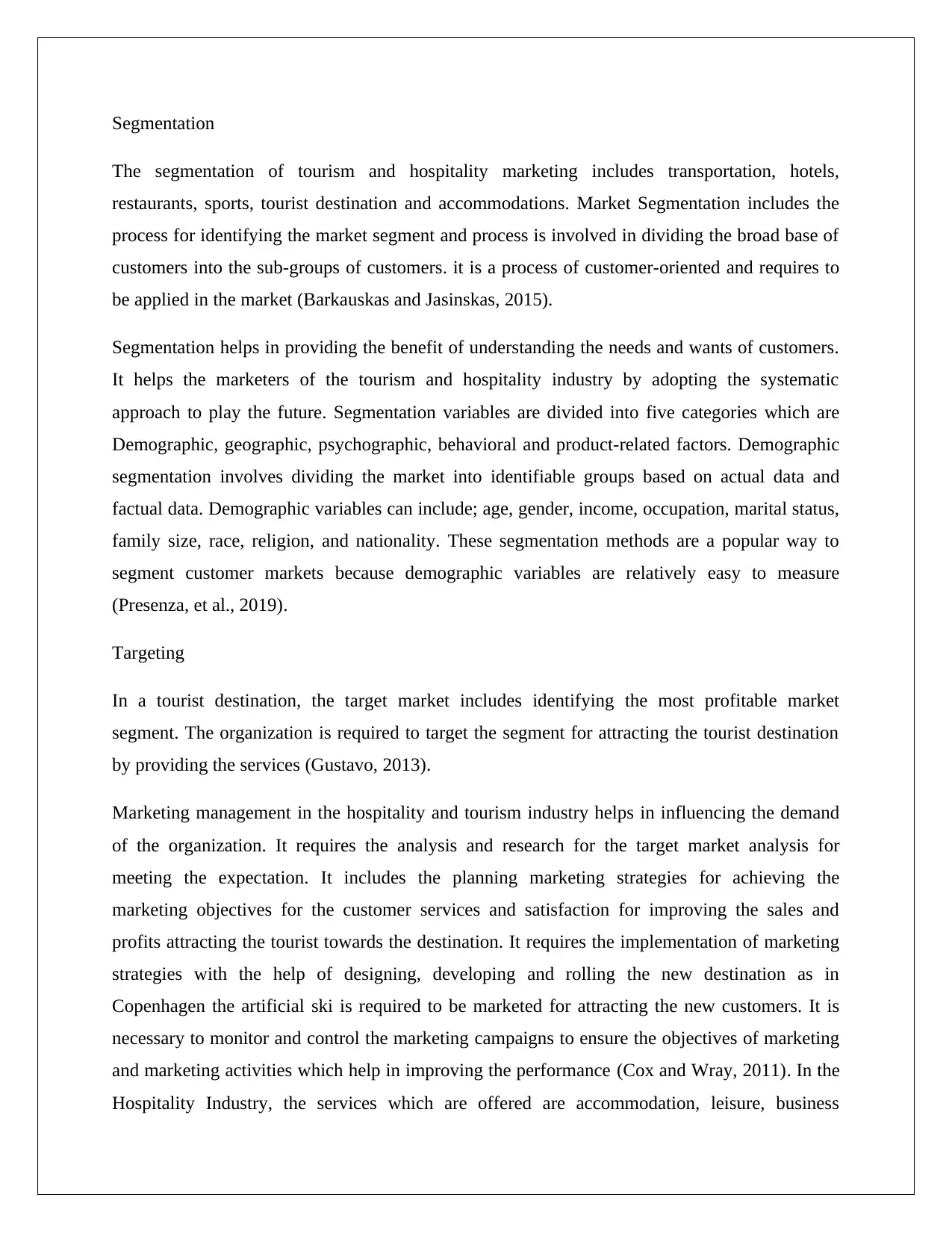
Segmentation
The segmentation of tourism and hospitality marketing includes transportation, hotels,
restaurants, sports, tourist destination and accommodations. Market Segmentation includes the
process for identifying the market segment and process is involved in dividing the broad base of
customers into the sub-groups of customers. it is a process of customer-oriented and requires to
be applied in the market (Barkauskas and Jasinskas, 2015).
Segmentation helps in providing the benefit of understanding the needs and wants of customers.
It helps the marketers of the tourism and hospitality industry by adopting the systematic
approach to play the future. Segmentation variables are divided into five categories which are
Demographic, geographic, psychographic, behavioral and product-related factors. Demographic
segmentation involves dividing the market into identifiable groups based on actual data and
factual data. Demographic variables can include; age, gender, income, occupation, marital status,
family size, race, religion, and nationality. These segmentation methods are a popular way to
segment customer markets because demographic variables are relatively easy to measure
(Presenza, et al., 2019).
Targeting
In a tourist destination, the target market includes identifying the most profitable market
segment. The organization is required to target the segment for attracting the tourist destination
by providing the services (Gustavo, 2013).
Marketing management in the hospitality and tourism industry helps in influencing the demand
of the organization. It requires the analysis and research for the target market analysis for
meeting the expectation. It includes the planning marketing strategies for achieving the
marketing objectives for the customer services and satisfaction for improving the sales and
profits attracting the tourist towards the destination. It requires the implementation of marketing
strategies with the help of designing, developing and rolling the new destination as in
Copenhagen the artificial ski is required to be marketed for attracting the new customers. It is
necessary to monitor and control the marketing campaigns to ensure the objectives of marketing
and marketing activities which help in improving the performance (Cox and Wray, 2011). In the
Hospitality Industry, the services which are offered are accommodation, leisure, business
The segmentation of tourism and hospitality marketing includes transportation, hotels,
restaurants, sports, tourist destination and accommodations. Market Segmentation includes the
process for identifying the market segment and process is involved in dividing the broad base of
customers into the sub-groups of customers. it is a process of customer-oriented and requires to
be applied in the market (Barkauskas and Jasinskas, 2015).
Segmentation helps in providing the benefit of understanding the needs and wants of customers.
It helps the marketers of the tourism and hospitality industry by adopting the systematic
approach to play the future. Segmentation variables are divided into five categories which are
Demographic, geographic, psychographic, behavioral and product-related factors. Demographic
segmentation involves dividing the market into identifiable groups based on actual data and
factual data. Demographic variables can include; age, gender, income, occupation, marital status,
family size, race, religion, and nationality. These segmentation methods are a popular way to
segment customer markets because demographic variables are relatively easy to measure
(Presenza, et al., 2019).
Targeting
In a tourist destination, the target market includes identifying the most profitable market
segment. The organization is required to target the segment for attracting the tourist destination
by providing the services (Gustavo, 2013).
Marketing management in the hospitality and tourism industry helps in influencing the demand
of the organization. It requires the analysis and research for the target market analysis for
meeting the expectation. It includes the planning marketing strategies for achieving the
marketing objectives for the customer services and satisfaction for improving the sales and
profits attracting the tourist towards the destination. It requires the implementation of marketing
strategies with the help of designing, developing and rolling the new destination as in
Copenhagen the artificial ski is required to be marketed for attracting the new customers. It is
necessary to monitor and control the marketing campaigns to ensure the objectives of marketing
and marketing activities which help in improving the performance (Cox and Wray, 2011). In the
Hospitality Industry, the services which are offered are accommodation, leisure, business
Paraphrase This Document
Need a fresh take? Get an instant paraphrase of this document with our AI Paraphraser
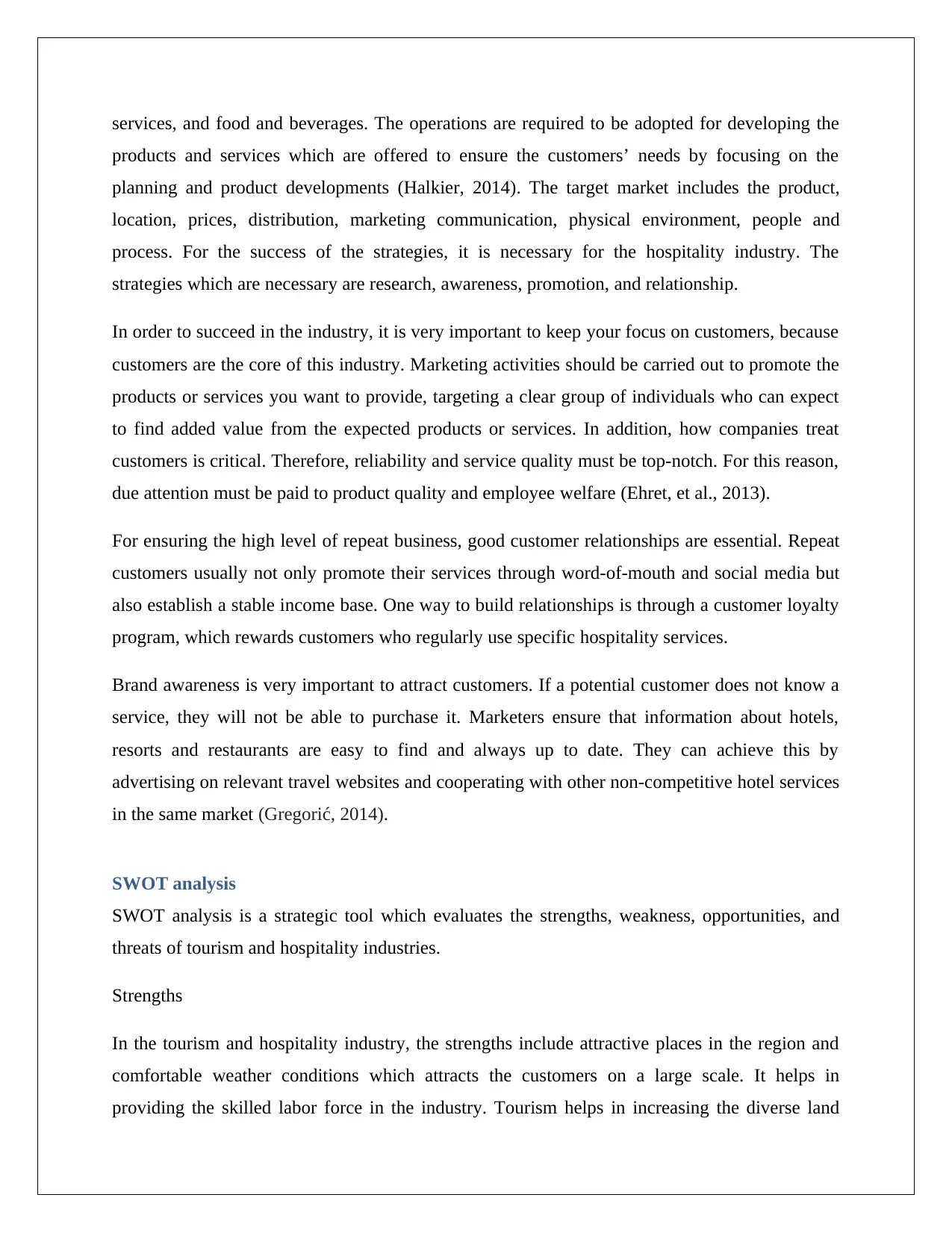
services, and food and beverages. The operations are required to be adopted for developing the
products and services which are offered to ensure the customers’ needs by focusing on the
planning and product developments (Halkier, 2014). The target market includes the product,
location, prices, distribution, marketing communication, physical environment, people and
process. For the success of the strategies, it is necessary for the hospitality industry. The
strategies which are necessary are research, awareness, promotion, and relationship.
In order to succeed in the industry, it is very important to keep your focus on customers, because
customers are the core of this industry. Marketing activities should be carried out to promote the
products or services you want to provide, targeting a clear group of individuals who can expect
to find added value from the expected products or services. In addition, how companies treat
customers is critical. Therefore, reliability and service quality must be top-notch. For this reason,
due attention must be paid to product quality and employee welfare (Ehret, et al., 2013).
For ensuring the high level of repeat business, good customer relationships are essential. Repeat
customers usually not only promote their services through word-of-mouth and social media but
also establish a stable income base. One way to build relationships is through a customer loyalty
program, which rewards customers who regularly use specific hospitality services.
Brand awareness is very important to attract customers. If a potential customer does not know a
service, they will not be able to purchase it. Marketers ensure that information about hotels,
resorts and restaurants are easy to find and always up to date. They can achieve this by
advertising on relevant travel websites and cooperating with other non-competitive hotel services
in the same market (Gregorić, 2014).
SWOT analysis
SWOT analysis is a strategic tool which evaluates the strengths, weakness, opportunities, and
threats of tourism and hospitality industries.
Strengths
In the tourism and hospitality industry, the strengths include attractive places in the region and
comfortable weather conditions which attracts the customers on a large scale. It helps in
providing the skilled labor force in the industry. Tourism helps in increasing the diverse land
products and services which are offered to ensure the customers’ needs by focusing on the
planning and product developments (Halkier, 2014). The target market includes the product,
location, prices, distribution, marketing communication, physical environment, people and
process. For the success of the strategies, it is necessary for the hospitality industry. The
strategies which are necessary are research, awareness, promotion, and relationship.
In order to succeed in the industry, it is very important to keep your focus on customers, because
customers are the core of this industry. Marketing activities should be carried out to promote the
products or services you want to provide, targeting a clear group of individuals who can expect
to find added value from the expected products or services. In addition, how companies treat
customers is critical. Therefore, reliability and service quality must be top-notch. For this reason,
due attention must be paid to product quality and employee welfare (Ehret, et al., 2013).
For ensuring the high level of repeat business, good customer relationships are essential. Repeat
customers usually not only promote their services through word-of-mouth and social media but
also establish a stable income base. One way to build relationships is through a customer loyalty
program, which rewards customers who regularly use specific hospitality services.
Brand awareness is very important to attract customers. If a potential customer does not know a
service, they will not be able to purchase it. Marketers ensure that information about hotels,
resorts and restaurants are easy to find and always up to date. They can achieve this by
advertising on relevant travel websites and cooperating with other non-competitive hotel services
in the same market (Gregorić, 2014).
SWOT analysis
SWOT analysis is a strategic tool which evaluates the strengths, weakness, opportunities, and
threats of tourism and hospitality industries.
Strengths
In the tourism and hospitality industry, the strengths include attractive places in the region and
comfortable weather conditions which attracts the customers on a large scale. It helps in
providing the skilled labor force in the industry. Tourism helps in increasing the diverse land
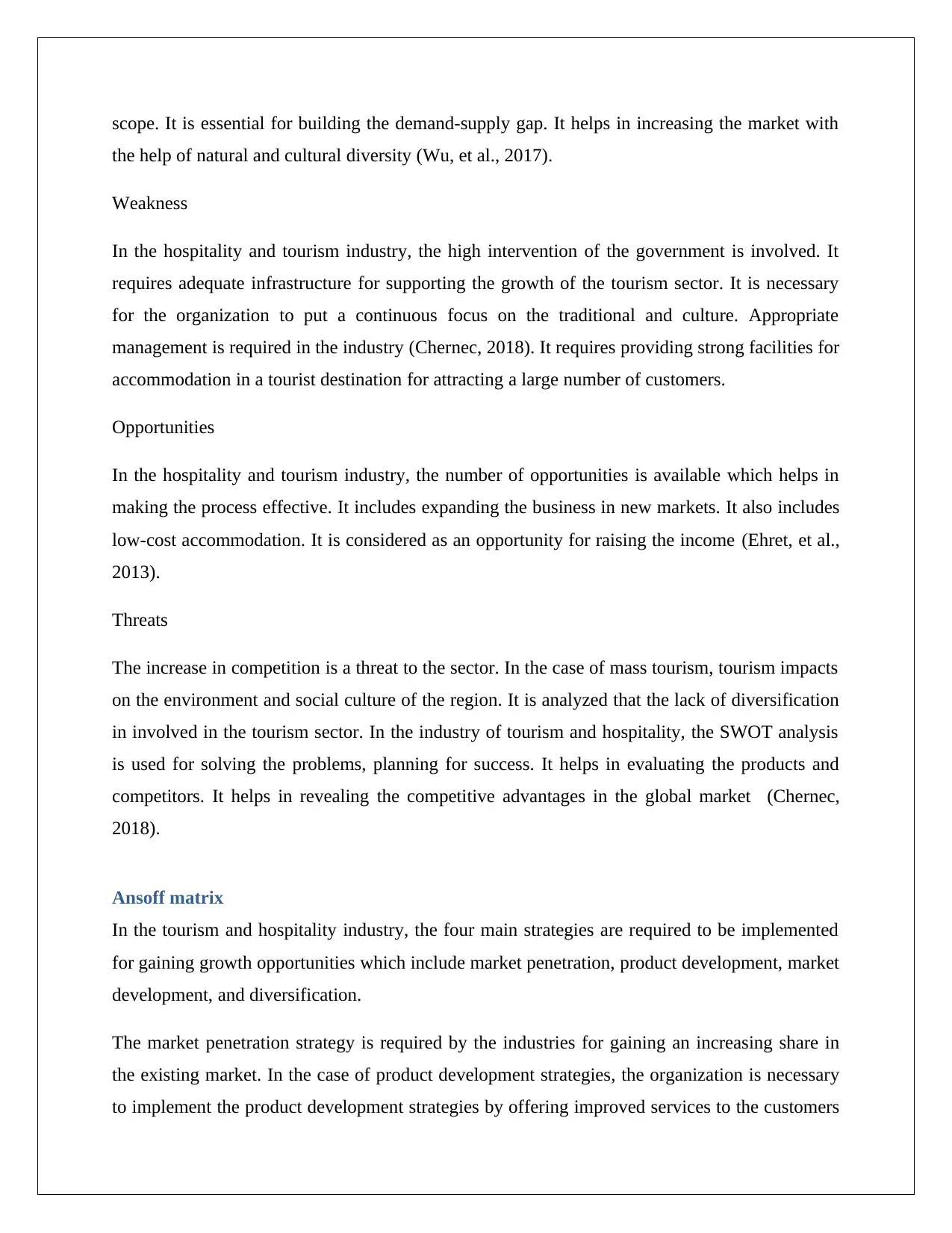
scope. It is essential for building the demand-supply gap. It helps in increasing the market with
the help of natural and cultural diversity (Wu, et al., 2017).
Weakness
In the hospitality and tourism industry, the high intervention of the government is involved. It
requires adequate infrastructure for supporting the growth of the tourism sector. It is necessary
for the organization to put a continuous focus on the traditional and culture. Appropriate
management is required in the industry (Chernec, 2018). It requires providing strong facilities for
accommodation in a tourist destination for attracting a large number of customers.
Opportunities
In the hospitality and tourism industry, the number of opportunities is available which helps in
making the process effective. It includes expanding the business in new markets. It also includes
low-cost accommodation. It is considered as an opportunity for raising the income (Ehret, et al.,
2013).
Threats
The increase in competition is a threat to the sector. In the case of mass tourism, tourism impacts
on the environment and social culture of the region. It is analyzed that the lack of diversification
in involved in the tourism sector. In the industry of tourism and hospitality, the SWOT analysis
is used for solving the problems, planning for success. It helps in evaluating the products and
competitors. It helps in revealing the competitive advantages in the global market (Chernec,
2018).
Ansoff matrix
In the tourism and hospitality industry, the four main strategies are required to be implemented
for gaining growth opportunities which include market penetration, product development, market
development, and diversification.
The market penetration strategy is required by the industries for gaining an increasing share in
the existing market. In the case of product development strategies, the organization is necessary
to implement the product development strategies by offering improved services to the customers
the help of natural and cultural diversity (Wu, et al., 2017).
Weakness
In the hospitality and tourism industry, the high intervention of the government is involved. It
requires adequate infrastructure for supporting the growth of the tourism sector. It is necessary
for the organization to put a continuous focus on the traditional and culture. Appropriate
management is required in the industry (Chernec, 2018). It requires providing strong facilities for
accommodation in a tourist destination for attracting a large number of customers.
Opportunities
In the hospitality and tourism industry, the number of opportunities is available which helps in
making the process effective. It includes expanding the business in new markets. It also includes
low-cost accommodation. It is considered as an opportunity for raising the income (Ehret, et al.,
2013).
Threats
The increase in competition is a threat to the sector. In the case of mass tourism, tourism impacts
on the environment and social culture of the region. It is analyzed that the lack of diversification
in involved in the tourism sector. In the industry of tourism and hospitality, the SWOT analysis
is used for solving the problems, planning for success. It helps in evaluating the products and
competitors. It helps in revealing the competitive advantages in the global market (Chernec,
2018).
Ansoff matrix
In the tourism and hospitality industry, the four main strategies are required to be implemented
for gaining growth opportunities which include market penetration, product development, market
development, and diversification.
The market penetration strategy is required by the industries for gaining an increasing share in
the existing market. In the case of product development strategies, the organization is necessary
to implement the product development strategies by offering improved services to the customers
⊘ This is a preview!⊘
Do you want full access?
Subscribe today to unlock all pages.

Trusted by 1+ million students worldwide
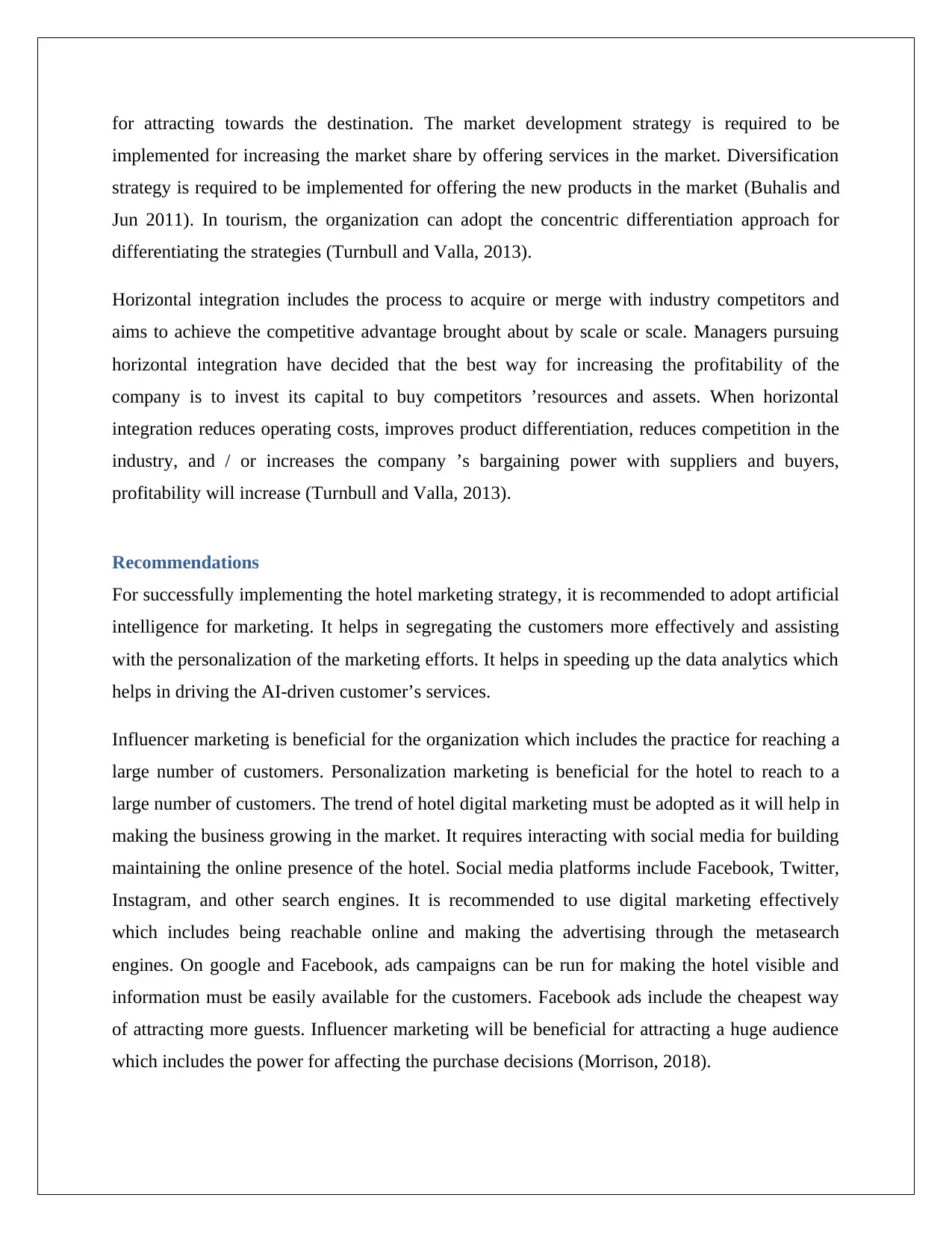
for attracting towards the destination. The market development strategy is required to be
implemented for increasing the market share by offering services in the market. Diversification
strategy is required to be implemented for offering the new products in the market (Buhalis and
Jun 2011). In tourism, the organization can adopt the concentric differentiation approach for
differentiating the strategies (Turnbull and Valla, 2013).
Horizontal integration includes the process to acquire or merge with industry competitors and
aims to achieve the competitive advantage brought about by scale or scale. Managers pursuing
horizontal integration have decided that the best way for increasing the profitability of the
company is to invest its capital to buy competitors ’resources and assets. When horizontal
integration reduces operating costs, improves product differentiation, reduces competition in the
industry, and / or increases the company ’s bargaining power with suppliers and buyers,
profitability will increase (Turnbull and Valla, 2013).
Recommendations
For successfully implementing the hotel marketing strategy, it is recommended to adopt artificial
intelligence for marketing. It helps in segregating the customers more effectively and assisting
with the personalization of the marketing efforts. It helps in speeding up the data analytics which
helps in driving the AI-driven customer’s services.
Influencer marketing is beneficial for the organization which includes the practice for reaching a
large number of customers. Personalization marketing is beneficial for the hotel to reach to a
large number of customers. The trend of hotel digital marketing must be adopted as it will help in
making the business growing in the market. It requires interacting with social media for building
maintaining the online presence of the hotel. Social media platforms include Facebook, Twitter,
Instagram, and other search engines. It is recommended to use digital marketing effectively
which includes being reachable online and making the advertising through the metasearch
engines. On google and Facebook, ads campaigns can be run for making the hotel visible and
information must be easily available for the customers. Facebook ads include the cheapest way
of attracting more guests. Influencer marketing will be beneficial for attracting a huge audience
which includes the power for affecting the purchase decisions (Morrison, 2018).
implemented for increasing the market share by offering services in the market. Diversification
strategy is required to be implemented for offering the new products in the market (Buhalis and
Jun 2011). In tourism, the organization can adopt the concentric differentiation approach for
differentiating the strategies (Turnbull and Valla, 2013).
Horizontal integration includes the process to acquire or merge with industry competitors and
aims to achieve the competitive advantage brought about by scale or scale. Managers pursuing
horizontal integration have decided that the best way for increasing the profitability of the
company is to invest its capital to buy competitors ’resources and assets. When horizontal
integration reduces operating costs, improves product differentiation, reduces competition in the
industry, and / or increases the company ’s bargaining power with suppliers and buyers,
profitability will increase (Turnbull and Valla, 2013).
Recommendations
For successfully implementing the hotel marketing strategy, it is recommended to adopt artificial
intelligence for marketing. It helps in segregating the customers more effectively and assisting
with the personalization of the marketing efforts. It helps in speeding up the data analytics which
helps in driving the AI-driven customer’s services.
Influencer marketing is beneficial for the organization which includes the practice for reaching a
large number of customers. Personalization marketing is beneficial for the hotel to reach to a
large number of customers. The trend of hotel digital marketing must be adopted as it will help in
making the business growing in the market. It requires interacting with social media for building
maintaining the online presence of the hotel. Social media platforms include Facebook, Twitter,
Instagram, and other search engines. It is recommended to use digital marketing effectively
which includes being reachable online and making the advertising through the metasearch
engines. On google and Facebook, ads campaigns can be run for making the hotel visible and
information must be easily available for the customers. Facebook ads include the cheapest way
of attracting more guests. Influencer marketing will be beneficial for attracting a huge audience
which includes the power for affecting the purchase decisions (Morrison, 2018).
Paraphrase This Document
Need a fresh take? Get an instant paraphrase of this document with our AI Paraphraser

Conclusion
This report is based on the macro-environmental analysis of the tourism and hospitality industry.
In the industry, competitive and environmental analysis helps in analyzing sustainable
development. This report includes the analysis of the Copenhagen artificial ski slope which is
developed for attracting the tourists. The marketing strategies which are adopted by the tourism
and hospitality industry will be analyzed. The marketing management functions will be
discussed which includes segmentation, targeting, positioning, and consumer behavior. In
implementing the marketing strategy, the various challenges are faced in the tourism and
hospitality industry. The SWOT analysis is included for analyzing the market segment and target
market. In the report, the Ansoff matrix has been discussed for analysing the marketing
objectives. The various recommendations are provided for the successful implementation of
hotel marketing strategies. It is analyzed that the tourism and hospitality are the growing sectors
which must implement effective strategies for growth and development.
This report is based on the macro-environmental analysis of the tourism and hospitality industry.
In the industry, competitive and environmental analysis helps in analyzing sustainable
development. This report includes the analysis of the Copenhagen artificial ski slope which is
developed for attracting the tourists. The marketing strategies which are adopted by the tourism
and hospitality industry will be analyzed. The marketing management functions will be
discussed which includes segmentation, targeting, positioning, and consumer behavior. In
implementing the marketing strategy, the various challenges are faced in the tourism and
hospitality industry. The SWOT analysis is included for analyzing the market segment and target
market. In the report, the Ansoff matrix has been discussed for analysing the marketing
objectives. The various recommendations are provided for the successful implementation of
hotel marketing strategies. It is analyzed that the tourism and hospitality are the growing sectors
which must implement effective strategies for growth and development.
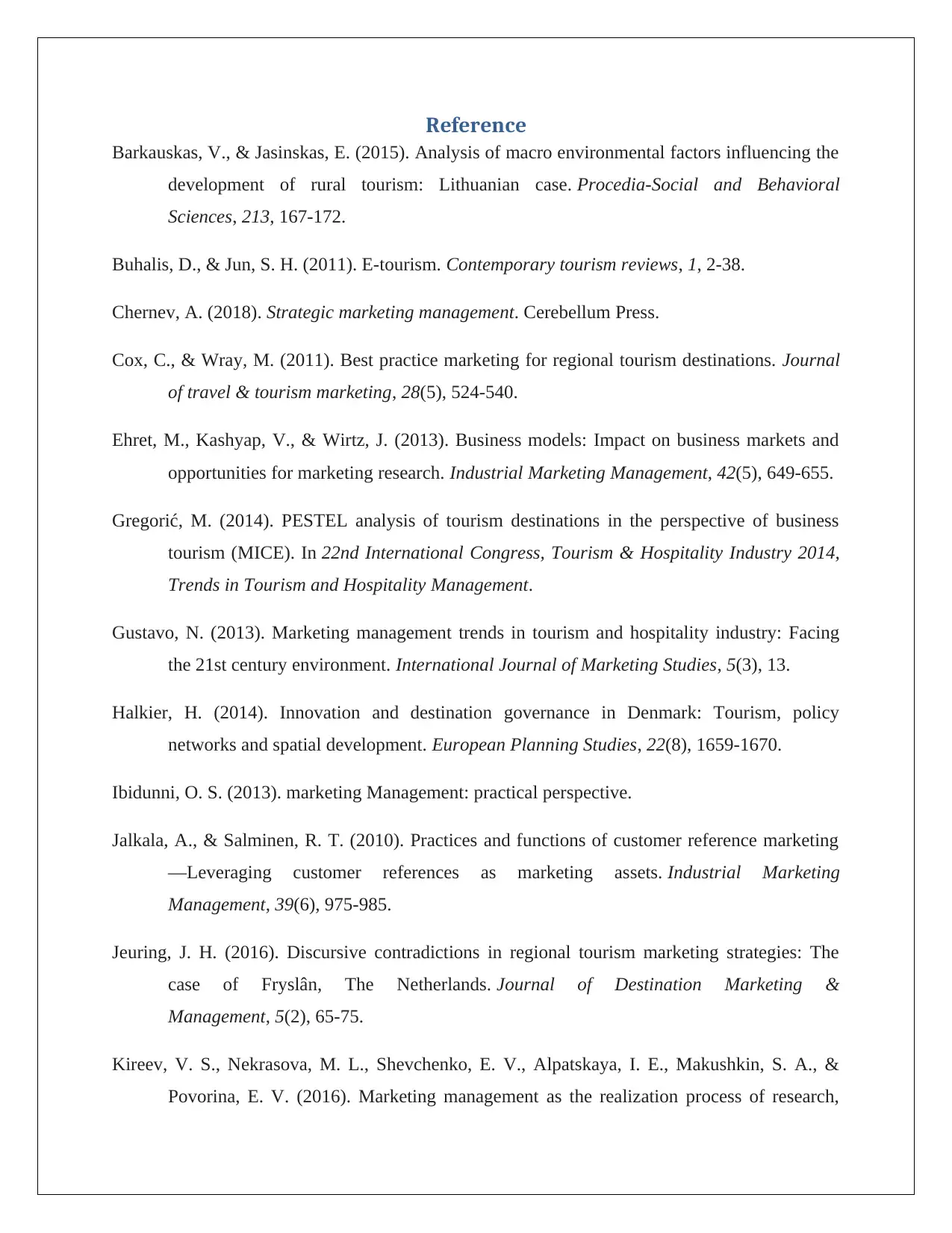
Reference
Barkauskas, V., & Jasinskas, E. (2015). Analysis of macro environmental factors influencing the
development of rural tourism: Lithuanian case. Procedia-Social and Behavioral
Sciences, 213, 167-172.
Buhalis, D., & Jun, S. H. (2011). E-tourism. Contemporary tourism reviews, 1, 2-38.
Chernev, A. (2018). Strategic marketing management. Cerebellum Press.
Cox, C., & Wray, M. (2011). Best practice marketing for regional tourism destinations. Journal
of travel & tourism marketing, 28(5), 524-540.
Ehret, M., Kashyap, V., & Wirtz, J. (2013). Business models: Impact on business markets and
opportunities for marketing research. Industrial Marketing Management, 42(5), 649-655.
Gregorić, M. (2014). PESTEL analysis of tourism destinations in the perspective of business
tourism (MICE). In 22nd International Congress, Tourism & Hospitality Industry 2014,
Trends in Tourism and Hospitality Management.
Gustavo, N. (2013). Marketing management trends in tourism and hospitality industry: Facing
the 21st century environment. International Journal of Marketing Studies, 5(3), 13.
Halkier, H. (2014). Innovation and destination governance in Denmark: Tourism, policy
networks and spatial development. European Planning Studies, 22(8), 1659-1670.
Ibidunni, O. S. (2013). marketing Management: practical perspective.
Jalkala, A., & Salminen, R. T. (2010). Practices and functions of customer reference marketing
—Leveraging customer references as marketing assets. Industrial Marketing
Management, 39(6), 975-985.
Jeuring, J. H. (2016). Discursive contradictions in regional tourism marketing strategies: The
case of Fryslân, The Netherlands. Journal of Destination Marketing &
Management, 5(2), 65-75.
Kireev, V. S., Nekrasova, M. L., Shevchenko, E. V., Alpatskaya, I. E., Makushkin, S. A., &
Povorina, E. V. (2016). Marketing management as the realization process of research,
Barkauskas, V., & Jasinskas, E. (2015). Analysis of macro environmental factors influencing the
development of rural tourism: Lithuanian case. Procedia-Social and Behavioral
Sciences, 213, 167-172.
Buhalis, D., & Jun, S. H. (2011). E-tourism. Contemporary tourism reviews, 1, 2-38.
Chernev, A. (2018). Strategic marketing management. Cerebellum Press.
Cox, C., & Wray, M. (2011). Best practice marketing for regional tourism destinations. Journal
of travel & tourism marketing, 28(5), 524-540.
Ehret, M., Kashyap, V., & Wirtz, J. (2013). Business models: Impact on business markets and
opportunities for marketing research. Industrial Marketing Management, 42(5), 649-655.
Gregorić, M. (2014). PESTEL analysis of tourism destinations in the perspective of business
tourism (MICE). In 22nd International Congress, Tourism & Hospitality Industry 2014,
Trends in Tourism and Hospitality Management.
Gustavo, N. (2013). Marketing management trends in tourism and hospitality industry: Facing
the 21st century environment. International Journal of Marketing Studies, 5(3), 13.
Halkier, H. (2014). Innovation and destination governance in Denmark: Tourism, policy
networks and spatial development. European Planning Studies, 22(8), 1659-1670.
Ibidunni, O. S. (2013). marketing Management: practical perspective.
Jalkala, A., & Salminen, R. T. (2010). Practices and functions of customer reference marketing
—Leveraging customer references as marketing assets. Industrial Marketing
Management, 39(6), 975-985.
Jeuring, J. H. (2016). Discursive contradictions in regional tourism marketing strategies: The
case of Fryslân, The Netherlands. Journal of Destination Marketing &
Management, 5(2), 65-75.
Kireev, V. S., Nekrasova, M. L., Shevchenko, E. V., Alpatskaya, I. E., Makushkin, S. A., &
Povorina, E. V. (2016). Marketing management as the realization process of research,
⊘ This is a preview!⊘
Do you want full access?
Subscribe today to unlock all pages.

Trusted by 1+ million students worldwide
1 out of 13
Related Documents
Your All-in-One AI-Powered Toolkit for Academic Success.
+13062052269
info@desklib.com
Available 24*7 on WhatsApp / Email
![[object Object]](/_next/static/media/star-bottom.7253800d.svg)
Unlock your academic potential
Copyright © 2020–2025 A2Z Services. All Rights Reserved. Developed and managed by ZUCOL.





